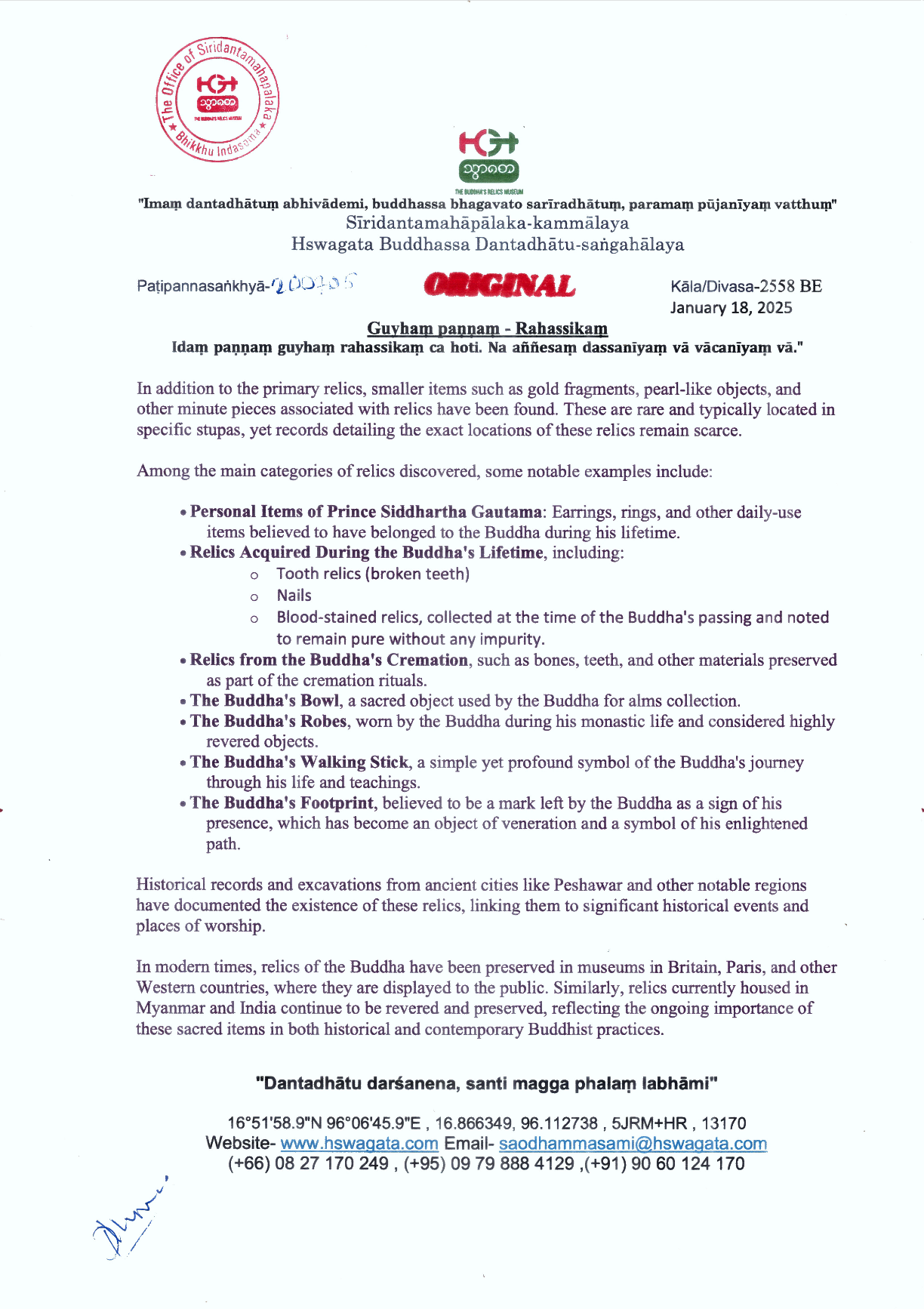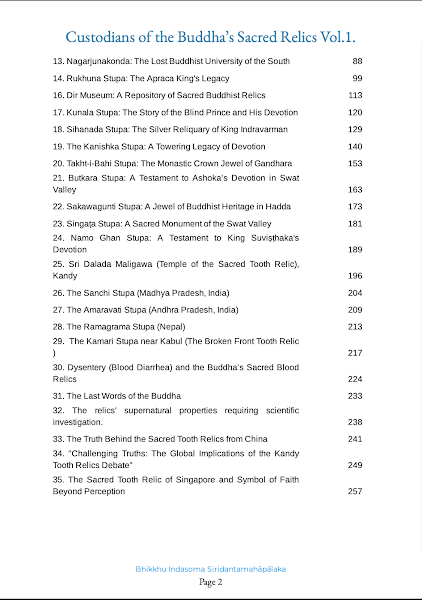anekajātisaṃsāraṃ sandhāvissaṃ anibbisaṃ gahakāraṃ gavesanto dukkhājāti punaṃppunaṃ sabbā te phāsukā aggā gahakūṭaṃ visaṅkhataṃ visaṅkhāra gataṃ cittaṃ taṇhānaṃ khaya majjyagā
ဝန္ဒာမိ
Friday, January 24, 2025
Wednesday, January 22, 2025
The Kissanapath Monastery and The Robe of the Lord Buddha
Abstract
This article examines the historical evolution, cultural significance, and enduring legacy of the Kissanapath Monastery, established in the 11th century by Atissaraka (1008–1064). Tracing its tumultuous history through invasions, natural disasters, and restorative efforts, the study explores the monastery’s role in housing sacred Buddha relics and its importance within the Gelugpa tradition. Emphasis is placed on the interplay of preservation, spiritual practice, and historical memory as the monastery navigated the challenges of colonial and post-colonial eras.
Introduction
The Kissanapath Monastery, situated amidst the rugged terrain of the Himalayas, stands as a testament to the resilience of Buddhist heritage. Founded in the 11th century by the renowned abbot Atissaraka, the monastery’s history reflects the interplay of spiritual devotion, political upheaval, and environmental challenges. Over centuries, the monastery has been a custodian of two sacred robes and other relics tied to the Buddha and King Suddhodana, lending it immense religious and cultural significance.
This article delves into the intricate tapestry of events that shaped the Kissanapath Monastery, from its destruction under Mongol invasions during the reign of the Fifth Dalai Lama to restoration efforts in the 20th century. It further examines the monastery’s murals, artifacts, and evolving role within the Gelugpa sect alongside sister monasteries such as Siri Pattavihara and Galyasiri Vihara.
Historical Evolution and Significance
The monastery’s establishment in the 11th century marked a significant phase in the dissemination of Buddhist practice in the region. Atissaraka’s vision for the monastery was deeply rooted in preserving sacred relics, including robes once offered by King Suddhodana to the Buddha. These robes, entwined with narratives of spiritual attainment, symbolize milestones in Buddhist teachings, inspiring adherents to this day.
During the mid-17th century, the Mongol invasions led by allies of the Fifth Dalai Lama caused extensive damage to the monastery, a pattern repeated in subsequent centuries. The Dogra army’s incursions in 1841 under Ghulam and Rahim Khan, coupled with natural calamities such as fires in the 1840s and an earthquake in 1975, further tested the resilience of this spiritual haven. However, restoration efforts spearheaded by the Archaeological Survey of India and local authorities revitalized the structure, ensuring its survival for future generations.
Religious Artifacts and Practices
Among the treasures housed in Kissanapath Monastery are murals depicting pivotal moments, such as King Suddhodana offering robes to the Buddha. The monastery’s architecture—a three-story structure with an underground chamber for preserving relics—is a hallmark of Buddhist monastic design. The Tansong chamber’s gilded murals and the assembly hall’s detailed adornments reflect the artistic and devotional zeal of its patrons.
The relics housed here have a storied past, with King Suddhodana’s re-offerings of robes symbolizing progressive spiritual attainments. These narratives underscore the monastery’s role in perpetuating the Buddha’s teachings, acting as a bridge between ancient traditions and contemporary practice.
Conclusion
The Kissanapath Monastery is said to have been founded in the 11th century by the renowned abbot Atissaraka (1008–1064). In the mid-17th century, during the reign of the Fifth Dalai Lama, the monastery suffered destruction at the hands of the Mongols. Around 1821, conflicts erupted between the Ladakh and Kullu clans. In 1841, the Dogra army under Ghulam Khan and Rahim Khan inflicted severe destruction on the monastery. Later that year, the Sikh community also faced attacks. During the 1840s, the monastery was damaged by fire, and in 1975, it was struck by a severe earthquake. Restoration efforts were carried out with the support of the Archaeological Survey of India and the State Public Works Department. The walls of the monastery are adorned with mural paintings depicting King Suddhodana offering robes. The Kissanapath Monastery houses a collection of ancient murals, Buddha images, and books. The three-story structure's most significant area is the underground chamber, used to preserve two sacred robes and other relics. A chamber known as “Tansong” is decorated with gilded mural paintings. The ground floor features a beautifully adorned assembly hall and quarters for numerous monks. The monastery is now part of the Gelugpa sect, alongside the Siri Pattavihara Monastery and the Galyasiri Vihara Monastery. The sacred robes were personally sewn by King Suddhodana when inviting his son, the Buddha. He offered the first set of robes to his son as a royal gift. Following this, the Buddha preached the verses starting with Uttithe Napapajeya, which inspired King Suddhodana to reach the state of Sotapanna (Stream-Enterer). The Buddha wore the first robe for three days before relinquishing it as a royal offering to the Dhamma. King Suddhodana later re-sewed the robe and reoffered it to the Buddha. The Buddha then preached the verses beginning with Dhammanca Upasama, inspiring the King to attain Sakadagami (Once-Returner). The Buddha wore this robe until receiving the Ayusankha robe offered by Nakula’s parents. During King Udayabhadda’s reign, the monk Saratta discreetly carried two sacred robes. These robes, hidden from history for centuries, were later discovered to be housed in the Kissanapath Monastery built by Atissaraka in the 11th century. It was later learned that the Fifth Dalai Lama, with the help of the Mongols, attempted to retrieve these robes. In 1821 and 1841, further attempts were made from various locations to seize the sacred robes and other relics.
The Kissanapath Monastery stands as an enduring symbol of faith, resilience, and cultural heritage. Its history, marked by periods of devastation and renewal, offers valuable insights into the dynamic interplay of religion, politics, and cultural preservation. As a custodian of sacred relics and a beacon of spiritual practice, the monastery’s legacy continues to inspire devotion and scholarly inquiry.
Sao Dhammasami
Research Scholar /Author
Tuesday, January 21, 2025
The discovery of Buddha's finger relics Maggadipa Stupa in Logar Province, Afghanistan
The remarkable discovery of Buddha’s finger relics in the Logar Province of Afghanistan stands as a profound testament to the region’s historical and cultural prominence during the Kushan Empire. This empire, flourishing between the early first century CE and the third century CE, played a pivotal role in shaping the religious and artistic landscapes of Central and South Asia.
The Kushan Empire: A Nexus of Culture and Faith
Under the Kushan rulers, particularly during the reign of Emperor Vasudeva I, the sixth ruler of the dynasty, the empire became a hub of cultural exchanges. The Kushans, known for their patronage of Buddhism, facilitated the propagation of the faith across vast territories. Their era was characterized by a unique syncretism between Indo-Greek artistic traditions and Buddhist devotional practices. This fusion is evident in the architectural styles and sculptural motifs that emerged during the period, blending Hellenistic, Indian, and Central Asian influences.
The Maggadipa Stupa: A Testament to Devotion
The Maggadipa Stupa, associated with the relics, is a prime example of the spiritual and architectural endeavors of the Kushan era. This monument not only served as a religious sanctuary but also as a symbol of the empire’s dedication to the dissemination of Buddhist teachings. The stupa’s design, influenced by both Indian and Greek architectural principles, reflects the cultural syncretism of the time.
Bhikkhu Indasoma Siridantamahapalaka's research (October 28, 2022) located these relics, Preserved by Naga.
Sunday, January 19, 2025
Comprehensive Statement on the Discovery and Research of Buddha Relics
Namo Tassa Bhagavato Arahato Samma Sambuddhassa
Comprehensive Statement on the Discovery and Research of Buddha Relics
January 18, 2025
Recent scholarly research has unveiled a significant array of relics associated with the life, death, and cremation of the Lord Buddha. Despite these discoveries, detailed records of specific stupas housing these relics remain limited, with only 120 stupas documented to contain such sacred items. The types of relics identified include:
- Tooth Relics
- Bone Relics
- Fragments of Bone Relics
- Nails
- Hair Relics
- Pieces of Cremated Remains
- Relics from the Buddha's Cremation
- Blood Relics
- Ashes
- Relics Found at the Buddha's Burial Site
- Bowl
- Robes
- Walking Stick
- Footprint
Personal Items of Prince Siddhartha Gautama: Earrings, rings, and other daily-use items believed to have belonged to the Buddha during his lifetime.
Relics Acquired During the Buddha's Lifetime, including:
- Tooth relics (broken teeth)
- Nails
- Blood-stained relics, collected at the time of the Buddha's passing and noted to remain pure without any impurity.
Relics from the Buddha's Cremation, such as bones, teeth, and other materials preserved as part of the cremation rituals.
The Buddha's Bowl, a sacred object used by the Buddha for alms collection.
The Buddha's Robes, worn by the Buddha during his monastic life and considered highly revered objects.
The Buddha's Walking Stick, a simple yet profound symbol of the Buddha's journey through his life and teachings.
The Buddha's Footprint, believed to be a mark left by the Buddha as a sign of his presence, which has become an object of veneration and a symbol of his enlightened path.
Historical records and excavations from ancient cities like Peshawar and other notable regions have documented the existence of these relics, linking them to significant historical events and places of worship.
In modern times, relics of the Buddha have been preserved in museums in Britain, Paris, and other Western countries, where they are displayed to the public. Similarly, relics currently housed in Myanmar and India continue to be revered and preserved, reflecting the ongoing importance of these sacred items in both historical and contemporary Buddhist practices.
A particularly momentous discovery is the unearthing of the Broken Front Tooth Relics of the Lord Buddha. According to the Mahāparinibbāna Sutta, following the Buddha's passing and cremation, four tooth relics were preserved. Two of these relics were enshrined in mythological realms—Trāyastriṃśa Heaven and the domain of the Nāgarāja—while the other two were kept in earthly locations: Gandhāra and Kaliṅga.
Contact:
Sao Dhammasami
Researcher/Author
Ph.D(Candidate) ,M.A (Pali)
saodhammasami@hswagata.com
January 18, 2025
For further insights into the research findings featured in Custodians of the Buddha’s Sacred Relics Vol. 1: Discover the Legacy of Sacred Treasures, please refer to the references provided within the book.
References Book Details:
- Sao Dhammasami, @ Bhikkhu Indasoma Siridantamahāpālaka. (2025). Custodians of the Buddha’s Sacred Relics Vol. 1: Discover the Legacy of Sacred Treasures [ASIN: B0DT61C12R] (Kindle Edition). Amazon Kindle Direct Publishing. https://www.amazon.com/dp/B0DT61C12R
This publication unveils the rich heritage of sacred relics through meticulous research and detailed exploration, offering readers a deep understanding of their spiritual significance and cultural legacy.
Some Relics
The interview file for Relics Received will be posted shortly.
Saturday, January 18, 2025
The Incomparable Fragrance of Sīla
"Through conventional truth of consciousness-seeing, isn't it taught that we must believe in kamma-ownership right view (kammassakatā sammādiṭṭhi), the two aspects of unwholesome and wholesome kamma?
From killing living beings to taking intoxicants, from killing to wrong view - when one commits these, is it wholesome or unwholesome kamma?
Isn't it taught that due to unwholesome kamma, the resultant states immediately after death are hell realms, animal realm, hungry ghosts, and demons? Is this happiness or suffering? This is due to unwholesome kamma. Isn't this frightening?
From abstaining from killing to abstaining from intoxicants, from abstaining from killing to abstaining from wrong view - when one abstains, is it unwholesome or wholesome kamma? Due to wholesome kamma, isn't it taught that the results are human realm and six deva realms? Is this suffering or happiness? This comes from wholesome kamma. Isn't it proper to have faith in kamma?
#Will_one_who_believes_in_kamma_still_do_unwholesome_deeds? Unwholesome leads to suffering, wholesome leads to happiness. Therefore, isn't it taught that one must have faith in kamma and rely on wisdom?"
"So, one needs to understand the two types of kamma - wholesome and unwholesome. Some people don't understand this. In big cities like Mandalay and Yangon, they slaughter thousands of buffaloes and cattle, and tens of thousands of pigs daily.
Those who kill and sell these animals - is it wholesome or unwholesome? It's unwholesome. Does unwholesome lead to happiness or suffering? #It_leads_to_suffering. Yet when we look at these people, what do we see? They wear gold and diamonds.
Look at their elbows - gold bracelets almost reaching there. They eat abundantly. They have three cars - one for morning, one for afternoon, one for evening. They keep changing cars. They own three buildings. People say they're wealthy, right? Seeing their lifestyle, their living conditions.
People say they're very wealthy, but they're doing unwholesome work. Didn't the Buddha teach that unwholesome actions lead to suffering? Despite the Buddha teaching this, why are these people prospering? Isn't this worth investigating? It's because of their dana (generosity) and sila (morality) from many past lives.
Those wholesome kammas couldn't give results before, #but_now_they're_bearing_fruit. When wholesome kamma is giving results, can we see their unwholesome kamma's effects? Let's say this wholesome kamma has 15 years worth of results. During these 15 years, they live abundantly, eat high-quality food, wear fine clothes.
They buy the best cars. Isn't this worth studying and analyzing? But after 15 years, don't their unwholesome actions accumulate daily? While the wholesome kamma giving results decreases day by day - it had 15 years worth of results to give.
When 15 years are complete, doesn't the wholesome kamma run out? Then the unwholesome kamma takes over. Buffaloes die, cattle die, pigs die - they lose their capital. The meat they sell goes on credit. Eventually, they have no capital left. They have to sell their buildings, their cars, their jewelry."
This teaching uses a powerful example to illustrate how kamma works - showing how past wholesome kamma can temporarily mask the effects of current unwholesome actions, but eventually, all kamma bears its appropriate fruit. It's a warning about not being deceived by temporary prosperity while engaging in unwholesome actions.
One person receives guidance from good teachers. Don't they perform wholesome deeds from waking until sleeping? They do wholesome deeds daily. Isn't happiness said to come from wholesome deeds? Yet they have no food, no clothes, live in a hut, eat only boiled beans. Isn't this worth contemplating?
They do wholesome deeds daily. Isn't happiness said to come from wholesome deeds? Why aren't they prospering? Isn't this worth investigating? It's because of unwholesome deeds from many past lives - stealing others' food and clothes. #That_unwholesome_kamma_is_giving_results.
They do wholesome deeds daily, from waking until sleeping. Can they escape the results of past unwholesome kamma? Doesn't the Buddha teach 'kammam vipakassa'? As this unwholesome kamma gives results daily, doesn't it gradually decrease?
The unwholesome kamma might give results for 20 years. They do wholesome deeds daily but still struggle. However, they have faith in kamma. They think: #when_did_I_start_doing_wholesome_deeds? #how_old_am_I_now? They know #these_are_wholesome_deeds. They have faith.
In such circumstances, would they consider stealing, hunting, or robbing? #Having_faith_in_kamma, they understand: "I'm poor now because I stole others' food and clothes in past lives. That kamma is giving results." Don't they live with this understanding?
They do wholesome deeds daily, from waking until sleeping. They maintain the five precepts perfectly. Will such a #person_who_believes_in_kamma create new unwholesome kamma? No. When those 20 years of unwholesome kamma results are exhausted, doesn't it end?
When the unwholesome kamma is exhausted, a close friend gives them a lottery ticket. That's all they can afford. The lucky couple wins 300 lakhs. When unwholesome kamma is exhausted, doesn't wholesome kamma emerge?
This is kammassakatā sammādiṭṭhi - right view of ownership of kamma. One who believes in kamma and its results takes care of their precepts like they take care of their clothes. #They_are_complete_in_sīla. They earn honestly. They take only what comes through righteous means - sama-lobha, not visama-lobha (wrong desire)."
Then Matali and Vissakamma, Sakka's attendants, ask: 'Lord Sakka, when morning comes, you survey the human realm and bow - who are you bowing to?'
To those in the human realm who earn righteously and support their parents, do you hear? Those who support their spouses, those complete in sila (morality) who support their children and family, those who support their parents.
'I, Sakka, bow to such people,' he says. Even Sakka bows to them! That's how powerful the five precepts are, do you hear?"
This teaching illustrates the immense value of ethical living and caring for one's family through righteous means. It shows that even the king of devas, Sakka, pays respect to humans who maintain moral conduct and fulfill their family responsibilities through honest work. This emphasizes that true worth comes not from status or wealth, but from moral conduct and fulfilling one's duties righteously.
"Consider how valuable the Five Precepts are. Take perfumes from England or America - foreign fragrances. They might only be smelled within this Dhamma hall, not reaching the street. But the Five Precepts' fragrance spreads throughout the country.
Don't people say such a person has good character, good moral conduct? Don't they say they're very honest and upright? These words of praise spread throughout the country. Nothing has a better fragrance than sila (moral conduct). #Only_sila_produces_this_fragrance. Like a gentle breeze carrying flower fragrance, isn't this worth believing in?
When unwholesome kamma is exhausted and wholesome kamma bears fruit, doesn't one prosper? Consider those who prosper while doing unwholesome deeds - their unwholesome actions aren't apparent because #past_wholesome_kamma_is_giving_results. But when that past wholesome kamma is exhausted, doesn't the unwholesome suddenly appear? Then at death, can they escape the lower realms?
Isn't it worth having faith in kammassakatā sammādiṭṭhi - right view of ownership of kamma? Think about it. When wholesome kamma is exhausted, unwholesome takes over. When unwholesome kamma is exhausted, doesn't wholesome take over? #This_needs_to_be_believed.
Nothing is as powerful as the Five Precepts. It's called metta (loving-kindness) too. It's called paritta (protection) too. Without the Five Precepts, chant all you want - #these_parittas_won't_be_effective, do you hear? 'Mettā saddo ananto' - nothing equals the Five Precepts. Isn't this worth analyzing? This is fundamental..."
































